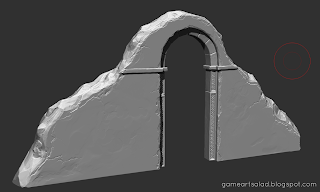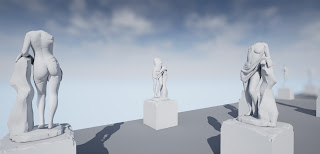Before I started doing this
project, had to think for some time how I want to approach texturing. To be
honest, I consider texturing my weakest discipline therefore whenever possible
I try to plan texturing out ASAP. With this project I decided to focus on
making good sculpts, extract relevant data (normal maps, AO, cavities, other
potential masks) and use that to blend bunch of stuff inside shader.
I’ve used this approach before
and always had good results with it. I’ve been inspecting Epic’s work on Unreal
Tournament and they doing fantastic job with it, lots of great things to learn
from there. The approach they quite often use is the one I’m using for this
project too, except that they tend to have even more masks and stuff than I do.
So here is the breakdown – I got
my masks in what I call mixmap, it’s a texture with a different mask in each
channel. I’m sure you’ve seen that stuff before. I got my AO in red channel,
cavity in green and edge highlights in blue. Rendered AO and Normal in Xnormal,
then passed the rendered normal map into Knald to get cavity and edge
highlights (or concavity and convexity info). Used Knald most because it’s so
much faster than rendering this stuff from high poly, even AO is pretty slow,
but it’s much more accurate than from Knald. I can live with cavity/edge
inaccuracies since I’ll be using them as simple masks, but I want AO to be good
because I’ll plug that directly into AO slot in Unreal shader. So those are the
maps so far – AO, Normal, Cavity, Edge highlights. Here is my shader noodle
soup:

I reckon the screenshot itself
isn’t much of a help for someone who wants to learn some stuff so I’m thinking
of releasing small project with just one asset, fully textured and with the
shader done. I can’t release whole project because it’s supposed to go to
Unreal Marketplace but I guess one asset wouldn’t hurt things and could prove
helpful to some folks.
So here is how the assets look so
far, some basic lighting/PP done too:
There also is the leaking stuff. For
that I’m using separate (3rd) UV channel, basically projected from
front. The leak texture is horizontally tiling, you can increase/decrease
tiling amount. Since its using projected UV map that took 5 secs to make there
is some unwanted, dare I say, leaking
here and there. Now I was considering several ways to get rid of that and the
easiest in my opinion is vertex painting. Leak texture is lerped on top of
everything else based on red vertex channel. So you can go to mesh paint mode
and manually mask out areas you don’t want the leaking to be at.
Will see how things will go from
there, there might be some problems with this lighting/PP setup in the long run
but nothing that can’t be solved.





































